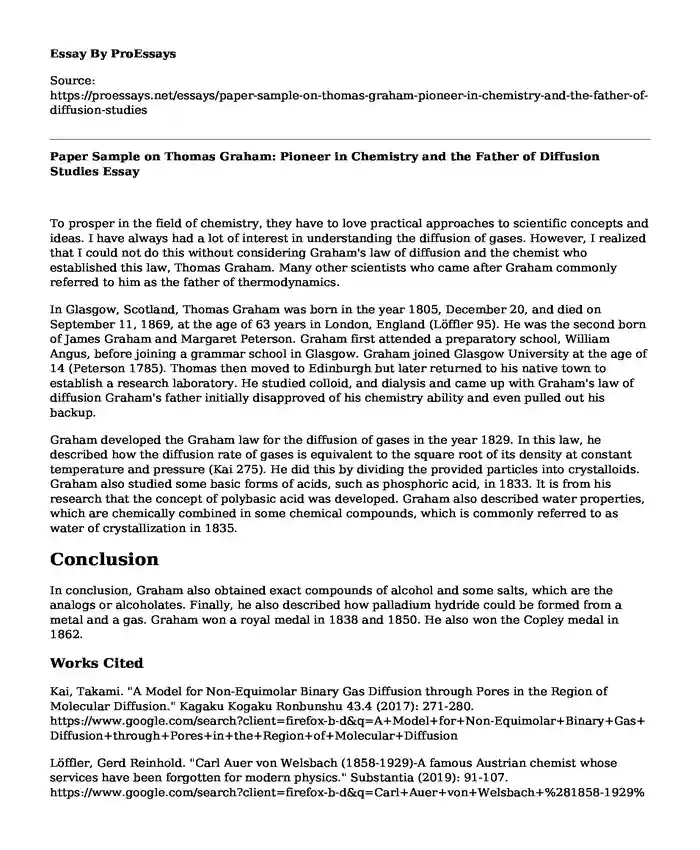To prosper in the field of chemistry, they have to love practical approaches to scientific concepts and ideas. I have always had a lot of interest in understanding the diffusion of gases. However, I realized that I could not do this without considering Graham's law of diffusion and the chemist who established this law, Thomas Graham. Many other scientists who came after Graham commonly referred to him as the father of thermodynamics.
In Glasgow, Scotland, Thomas Graham was born in the year 1805, December 20, and died on September 11, 1869, at the age of 63 years in London, England (Löffler 95). He was the second born of James Graham and Margaret Peterson. Graham first attended a preparatory school, William Angus, before joining a grammar school in Glasgow. Graham joined Glasgow University at the age of 14 (Peterson 1785). Thomas then moved to Edinburgh but later returned to his native town to establish a research laboratory. He studied colloid, and dialysis and came up with Graham's law of diffusion Graham's father initially disapproved of his chemistry ability and even pulled out his backup.
Graham developed the Graham law for the diffusion of gases in the year 1829. In this law, he described how the diffusion rate of gases is equivalent to the square root of its density at constant temperature and pressure (Kai 275). He did this by dividing the provided particles into crystalloids. Graham also studied some basic forms of acids, such as phosphoric acid, in 1833. It is from his research that the concept of polybasic acid was developed. Graham also described water properties, which are chemically combined in some chemical compounds, which is commonly referred to as water of crystallization in 1835.
Conclusion
In conclusion, Graham also obtained exact compounds of alcohol and some salts, which are the analogs or alcoholates. Finally, he also described how palladium hydride could be formed from a metal and a gas. Graham won a royal medal in 1838 and 1850. He also won the Copley medal in 1862.
Works Cited
Kai, Takami. "A Model for Non-Equimolar Binary Gas Diffusion through Pores in the Region of Molecular Diffusion." Kagaku Kogaku Ronbunshu 43.4 (2017): 271-280. https://www.google.com/search?client=firefox-b-d&q=A+Model+for+Non-Equimolar+Binary+Gas+Diffusion+through+Pores+in+the+Region+of+Molecular+Diffusion
Löffler, Gerd Reinhold. "Carl Auer von Welsbach (1858-1929)-A famous Austrian chemist whose services have been forgotten for modern physics." Substantia (2019): 91-107. https://www.google.com/search?client=firefox-b-d&q=Carl+Auer+von+Welsbach+%281858-1929%29-A+famous+Austrian+chemist+whose+services+have+been+forgotten+for+modern+physics
Paterson, Thomas Graham. "Aiton Families in New Brunswick: The Scottish Immigrant Hugh Aiton and His Descendants and Relatives in Canada." (2018). (1784-1862). https://www.google.com/search?client=firefox-b-d&q=Aiton+Families+in+New+Brunswick%3A+The+Scottish+Immigrant+Hugh+Aiton+and+His+Descendants+and+Relatives+in+Canada
Cite this page
Paper Sample on Thomas Graham: Pioneer in Chemistry and the Father of Diffusion Studies. (2023, Dec 13). Retrieved from https://proessays.net/essays/paper-sample-on-thomas-graham-pioneer-in-chemistry-and-the-father-of-diffusion-studies
If you are the original author of this essay and no longer wish to have it published on the ProEssays website, please click below to request its removal:
- Multiple Linear Regression Analysis Paper Example
- Heat Pipe Working Principles Essay
- Laboratory Report on CAT Hydroelectric Power Experiment Paper Example
- Essay Sample on Lion Felling a Bull, From a Marble Pediment
- Research Paper on Early American Civilizations: 10,000 Years of History
- Report Example on Environmental Movement
- Nucleotide Synthesis and Purification - Report Sample







